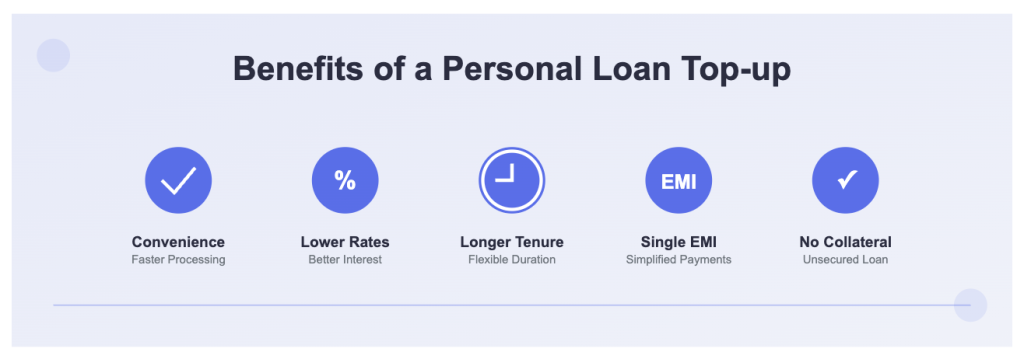Meet Ravi, a 35-year-old entrepreneur from Chennai. An year ago, he took out a personal loan to renovate his home. Now, with new business expansion plans in motion, he finds himself needing additional funds. Instead of applying for a brand-new loan, Ravi wonders if he can simply increase his existing loan. That’s when his bank suggests a personal loan top-up.
In India, many borrowers like Ravi find themselves needing extra funds after taking out an initial personal loan. Instead of going through the process of applying for a new loan, opting for a personal loan top-up can be a more convenient and cost-effective solution. In this blog post, we will explain how to get a personal loan top-up, the benefits it offers, and the key things to consider before applying.
What is a personal loan top-up?
Before diving into how to get a personal loan top-up, let’s first understand what it is. A personal loan top-up allows you to borrow additional funds on top of your existing personal loan. It’s like extending the loan limit, without having to go through the entire application process again. This option is available to borrowers who have been repaying their personal loans regularly and have maintained a good credit history.
For example, Ravi already has a personal loan for ₹5 lakhs that he took a year ago to renovate his home. Now, he needs an additional ₹2 lakhs for his business expansion. Instead of applying for a new loan, Ravi can ask his bank for a personal loan top-up on his existing loan. The bank reviews his payment history, and since Ravi has been paying his EMIs on time, they approve the top-up.
How to get a personal loan top-up in India
So, how does someone like Ravi go about getting a personal loan top-up? Here’s a step-by-step guide to help you understand the process:
Step 1: Check Your Eligibility
The first step in how to get a personal loan top-up is to check whether you’re eligible. To be eligible for a top-up, most banks require you to meet the following criteria:
- Good Repayment History: Lenders will check if you’ve been paying your existing loan EMIs on time. If you’ve missed or delayed payments, your chances of approval may decrease.
- Loan Tenure: Some banks require that a certain number of EMIs (e.g., 6–12 months) must be paid before you can apply for a top-up.
- Credit Score: Your credit score plays an important role in determining whether you’ll be approved for a top-up. A score above 700 is usually preferred.
In Ravi’s case, he’s been repaying his personal loan for 12 months and has a credit score of 750, making him eligible for a top-up.
Step 2: Contact Your Bank or Lender
Once you know you’re eligible, the next step is to contact your bank or lender and inquire about the process for getting a top-up. Ravi simply called his bank’s customer service and asked about the possibility of getting a personal loan top-up. His bank representative informed him of the options available and the required documents.
Lenders may offer top-ups through their online banking platforms, mobile apps, or branches. It’s a good idea to explore these different channels to see which one is most convenient for you.
Step 3: Submit Required Documents
Although a top-up loan is usually easier to process than a new loan, you may still need to provide some documentation to verify your current financial status. Commonly requested documents include:
- Income Proof: Salary slips for salaried employees, or income statements for self-employed individuals.
- Bank Statements: These help the bank assess your repayment capacity.
- Loan Account Statements: Proof of your existing loan and repayment history.
Ravi submitted his income proof (salary slips for the past 6 months) and his bank statements, which confirmed that he was capable of repaying the additional loan amount.
Step 4: Loan Review and Approval
Once you’ve submitted the required documents, the lender will review your application. They will assess your repayment history, credit score, and overall financial health. This review process is typically faster than applying for a new loan because the bank already has most of your details from the original loan.
In Ravi’s case, since he had a good repayment history and a strong credit score, his loan top-up application was approved within a few days.
Step 5: Loan Disbursement
Once the lender approves your top-up request, the additional loan amount is disbursed directly into your account. The top-up is usually added to your existing loan, meaning your EMIs will increase, but you won’t have to manage multiple loans.
Ravi’s bank disbursed the additional ₹2 lakhs directly into his bank account, and his new EMI amount was adjusted to reflect the total loan (₹5 lakhs + ₹2 lakhs). Ravi was relieved that the process was quick and hassle-free.
Related Read: Why it is important to use personal loans wisely: A guide for Indian borrowers
Key Things You Should Know About Personal Loans in India
Benefits of a personal loan top-up

1. Convenience
One of the biggest advantages of a personal loan top-up is convenience. Since you already have an existing loan with the lender, the process of getting a top-up is much faster than applying for a new loan. For someone like Ravi, who needed funds quickly, this saved him a lot of time and effort.
2. Lower Interest Rates
In some cases, lenders may offer lower interest rates on top-up loans compared to new personal loans. Since Ravi was an existing customer with a good repayment history, his bank offered him a slightly lower interest rate for the top-up compared to what they would offer for a fresh loan.
3. Longer Loan Tenure
When you opt for a personal loan top-up, you may be able to extend your loan tenure. This helps in spreading out the EMIs over a longer period, reducing the financial burden each month. However, it’s essential to keep in mind that a longer tenure may increase the total interest paid over time.
4. Single EMI Payment
With a personal loan top-up, you don’t have to juggle multiple loans. Instead of managing two separate loans with two different EMIs, the top-up is added to your existing loan, and you pay one consolidated EMI. For Ravi, this meant keeping his finances simple and organized.
5. No Need for Collateral
Just like your original personal loan, a top-up loan is unsecured, meaning you don’t need to pledge any assets or collateral to get it. This made it easier for Ravi to access the additional funds without worrying about risking his property.
Things to consider before getting a personal loan top-up
While a personal loan top-up can be a helpful solution, it’s important to carefully consider the following factors before proceeding:
1.Higher EMI: Since you’re increasing the loan amount, your monthly EMI will also increase. Make sure you’re financially comfortable with the new EMI before applying for a top-up.
2. Total Interest Cost: Even if the interest rate is lower, a top-up loan may extend the loan tenure, resulting in higher total interest payments over time. Use an EMI calculator to determine how much more you’ll be paying in interest.
3. Eligibility: Not all borrowers are eligible for a personal loan top-up. You must have a good repayment history and a decent credit score to qualify.
4. Impact on Credit Score: Taking on additional debt can impact your credit score. Ensure that you can manage the repayments on time to avoid damaging your credit score.
5. Processing Fees: Some banks charge processing fees for personal loan top-ups, so it’s important to inquire about any additional charges before applying.
In conclusion, knowing how to get a personal loan top-up can be a game-changer for borrowers who need additional funds without the hassle of applying for a new loan. Whether you’re like Ravi, looking to expand your business, or simply need extra money for other personal reasons, a top-up loan offers flexibility, convenience, and potentially lower interest rates. Just be sure to assess your financial situation and repayment capacity before taking the plunge!
FAQs
1. How to get a personal loan top-up?
To get a personal loan top-up, you need to check your eligibility, contact your bank or lender, submit the required documents, and wait for approval. Once approved, the top-up amount is disbursed to your account, and your EMIs are adjusted accordingly.
2. Is a personal loan top-up better than taking a new loan?
A personal loan top-up is often more convenient than applying for a new loan since the lender already has your details. It may also come with lower interest rates and the benefit of a single EMI payment.
3. What documents are required for a personal loan top-up?
Commonly required documents include income proof, bank statements, and loan account statements. Your lender may ask for additional documents based on your financial situation.
4. How long does it take to get a personal loan top-up approved?
The approval process for a personal loan top-up is usually faster than for a new loan, as the lender already has your information. In most cases, it takes a few days to get approval.
5. Can I extend my loan tenure with a personal loan top-up?
Yes, some lenders may allow you to extend the loan tenure when you take a personal loan top-up. This can help reduce your monthly EMIs, but it may result in higher total interest costs over time.



